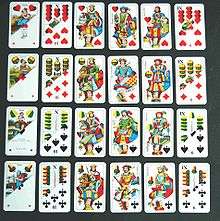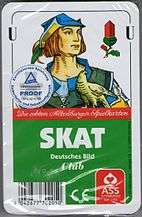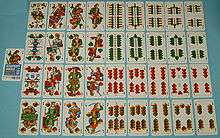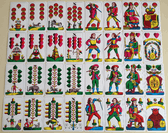German playing cards
| German | Hearts |
Bells |
Acorns |
Leaves |
| French | Hearts |
Tiles |
Clubs |
Spades |
German playing cards are a style of playing cards used is some parts of Central Europe. Playing cards (Spielkarten) entered German-speaking lands around the late 1370s. After much experimentation, the cards settled into new suits of Acorns (Eichel), Leaves (Grün or Blatt), Hearts (Herz) and Bells (Schelle) around 1450.[1] Closely related Swiss playing cards are used in German-speaking Switzerland. The French suit symbols were derived from the German ones around 1480. German-suited cards spread throughout Central Europe into areas that were once under German or Austrian control (Hungary, Slovenia, Slovakia, Czech Republic, Croatia, Transylvania, Banat, Vojvodina, South Tyrol, Transcarpathia, and parts of Poland). They were also produced and used as far east as Russia until the early 20th century. German-suited decks are not well known all over these countries including parts of Germany itself as they have been undergoing strong competition from French playing cards since the late 17th-century. Traditional card games in which the German suits are used include Skat, Schafkopf and Doppelkopf.
Composition
German suited decks tend to have fewer cards than either the French, Spanish, or Italian sets. The typical northern German pack goes from ranks 7, 8, 9, 10, Under Knave (Unter), Over Knave (Ober), King (König), and Ace (Ass) for a total of 32 cards. Southern patterns have 36 cards by including the 6. In Austria and South Tyrol, the 6 of Bells is known as the Weli which is often used as a wild card. The Weli first appeared around 1855 in the discontinued Tyrolean pattern and later the Salzburg and William Tell patterns. With the exception of the New Altenburg pattern, all cards with the rank of 10 include the Roman numeral X on the top center of the card.
The ace in German and Swiss German sets have a peculiar history. Aces disappeared from German decks during the 15th century. When the ace was promoted above the King in French packs during the 16th century, the deuce did so as well in Germany leading to the conflation of the ace and deuce. This is why in some sets the ace depicts two pips and is also called a daus (deuce). Confusion is avoided when the 7 or 6 became the lowest card in most packs during the 17th and 18th centuries.[1] Players also avoid confusion by alternatively calling the Ace/Deuce a sau (sow).
Many regions have their own pattern (Bild) which features their own unique artwork or number of cards. Some patterns are descended from much earlier ones like the Nürnberg and Saxon patterns which can trace their ancestry to the 15th-century Stukeley type cards named after their identifier, William Stukeley, in 1763.
Northern
Northern patterns have 32 cards and are used to play Skat. In northern patterns, the acorns are red. The only traditional northern pattern still in production is the Saxon pattern where only pip cards have corner indices. It is a product of a long evolution from the primitive Stukeley type cards imported from Nuremberg.[2] They have been marginalized by the New Altenburg or "German pattern" created during the former East Germany which added corner indices to every card but the Aces. True to socialist aesthetics, the Kings and Obers are depicted as pompous and arrogant while the Unters are heroic working class men.[3]
_07.png)
Southern
The 36 card Modern Bavarian, Franconian, and Salzburg patterns are descended from the Old Bavarian pattern which itself goes back to the 15th-century Augsburg pattern.[4][5] Their most notable feature are that the Obers and Unters are engaged in combat except in the suit of leaves where they are playing musical instruments. Since the 1980s, Italian manufacturers have included 5s into their Salzburg decks to allow the German speaking South Tyroleans to play Italian card games that require 40 cards with suits they are more familiar with. Salzburg decks also inherited the "Weli" from its extinct sibling, the Tyrolean pattern.[6]
The Bohemian (or Prague) pattern is also descended from the Old Bavarian but has only 32 cards like the northern ones. The Salzburg and Bohemian patterns are also not reversible and lack corner indices. Most games require only 32 cards by excluding the 6s such as Schafkopf. Games that require the full deck include Jass and Tarock.
Württemberg
The Württemberg pattern dates from the late nineteenth century and carries many unique features.[7] The kings were copied from French-suited patterns now found in the Netherlands and Portugal. The Obers were copied from the Knights in Adler Cego decks used in nearby Baden.[8] The cards are most often sold in a doubled pack of 48 cards (24 unique cards duplicated). The duplicated cards (7, 10, U, O, K, A of each suit) are used to play Doppelkopf, Pinochle, and Gaigel. They used to be produced in 36 card packs (with every card unique) like other southern patterns to play Württembergischer Tarock. Pressman Toy has published a 48 card version where every card is unique to play Karnöffel.[9] It is mislabeled as the Bavarian pattern.
William Tell
The William Tell pattern is popular throughout the former Austro-Hungarian Empire. The Ober and Unter cards depict William Tell and other characters from Friedrich Schiller's Wilhelm Tell (the title character is Ober of Acorns). The play's first Hungarian performance was in 1833 and the first decks date to around 1835.[10] The characters from the drama were chosen to avoid censorship at the time of the Hungarian opposition to Habsburg rule. The story, after all, was about a successful revolt against the Habsburgs.[11] When Austrians began producing this deck, they changed two of the characters. The Aces depict the four seasons which are also somewhat different in the Austrian and Hungarian versions. The Slovak-Moravian version follows the Austrian version but doesn't label the characters or the seasons. The Kings don't represent anyone in particular and are shown mounted on horses. Except for the Aces, all pip cards have Roman numerals. The suit symbols are also slightly different, most notably the leaves are now half yellow and ends with three tips. They come in packs of 32, 33 (with the Weli), or 36 cards. They are sometimes called "Swiss cards" due to the nationality of the characters but this pattern is not used in Switzerland.
German-French hybrid suited decks

After the unification and reunification of Germany, compromise decks were created to help players from around the country who were used to different suits. The Skat Kongress decks split cards diagonally with one half using the pattern with French suits and the other half using the pattern with German suits. This is not unique to Germany as similar split decks are found in Austria and Switzerland as well.
The Turnierbild pack was created for official Skat tournaments, using the French suited Berlin pattern but with German colours (green Spades and yellow Diamonds).[12]
See also
References
- 1 2 Dummett, Michael (1980). The Game of Tarot. London: Duckworth. pp. 10–29.
- ↑ Kranich, Jurgen; Radau, Sigmar; Schlede, Stefan (2009). Schwerdterkarten Band vol 1. Berlin: Studien zur Spielkarte.
- ↑ Pollett, Andrea. "Patterns from former East Germany". Andy's Playing Cards (archived). Archived from the original on March 5, 2008. Retrieved 2 February 2016.
- ↑ Hausler, Manfred (2006). "From Schongau to Saint Petersburg". The Playing-Card. 35 (2): 96–110.
- ↑ "Old Bavarian pattern". International Playing-Card Society. Retrieved 2 February 2016.
- ↑ "Later Tyrol pattern". International Playing-Card Society. Retrieved 2 February 2016.
- ↑ Württemberg pattern at the International Playing-Card Society. Retrieved 9 October 2016.
- ↑ Mann, Sylvia (1990). All Cards on the Table. Leinfelden: Deutsches Spielkarten-Museum. pp. 61–114.
- ↑ Karnöffel at BoardGameGeek. Retrieved 12 September 2015.
- ↑ Tell pattern type 1 at the International Playing-Card Society. Retrieved 9 October 2016.
- ↑ "Doppeldeutsch: Wilhelm Tell und die Ungarn (Tell cards history)". trift.org. Retrieved 20 June 2016.
- ↑ "Andy's Playing Cards - Shapes, Sizes and Colours". Archived from the original on February 21, 2009.




